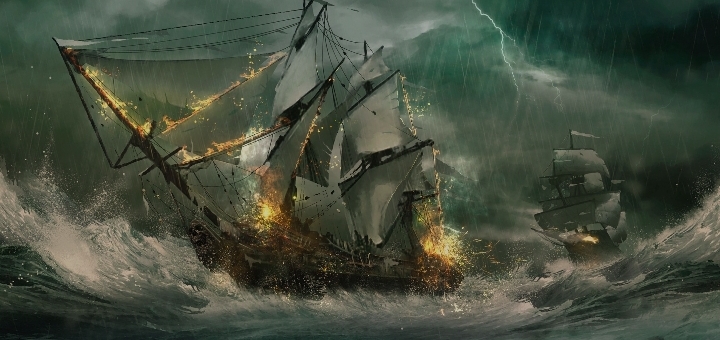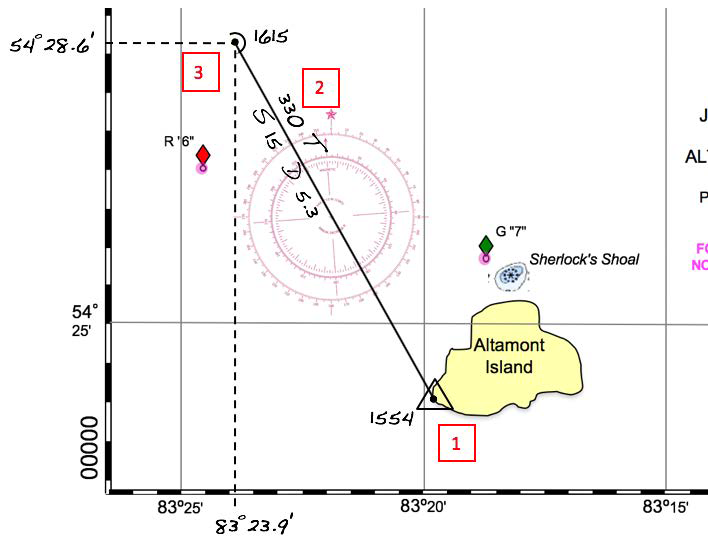In mid September a loaded container ship is in position 26˚ 30’ N 121˚ 20’ E bound through the strait of Taiwan
for Honkong, steaming on a SW’ly course at 16 kts. A weather report from indicates that a typhoon currently in
position 21˚ 30’ N 117˚ 15’ E has re-curved on to a NE path, moving at 25 kts
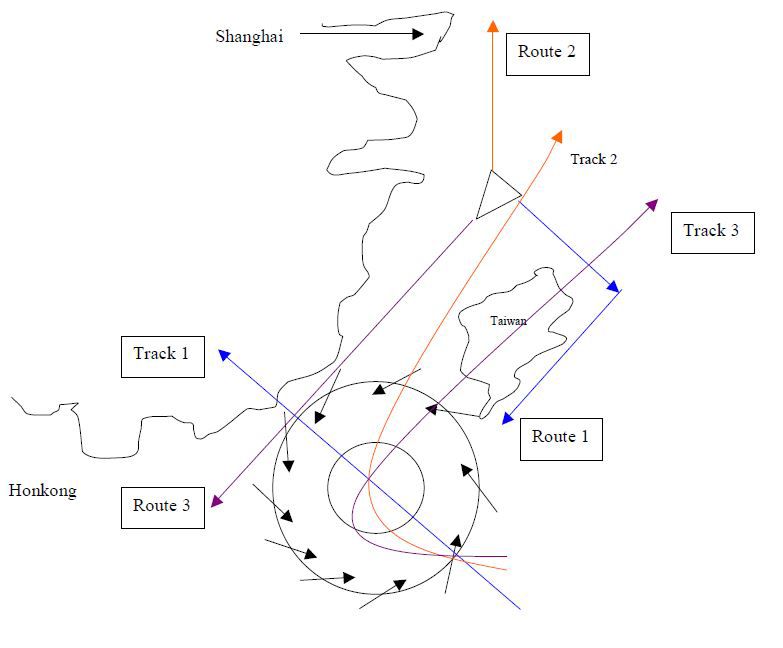
Storm Track 1 and Vessel Route 1:
If the TRS is proceeding on a NW course as most northern hemisphere TRS do before their recurvature
The vessel can follow Route 1.
Advantages:
- As long as the TRS is on this path the vessel will be well away from the storm centre and away from bad
weather.
Disadvantage:
- When the TRS eventually recurves and if it proceeds as in track 3 then the vessel might be in the path of the
storm and in the dangerous semicircle. Vessel will be subject to severe weather damage. - Vessel is in the dangerous semicircle even thought not in the dangerous quadrant.
- Also the wind circulation when the vessel is off the coast will be so as to drive the vessel towards the shore
(Lee shore). In case of loss of engine or steering this could be dangerous. - Extra distance steamed and subsequent loss of revenue.
Storm Track 2 and Vessel Route 2:
- The present direction of the TRS is NE 25 kts and this indicates clearly that the storm has attained its latitude of
recurvature and recurved. The storm is likely to continue on this track till it loses its energy. - But the TRS have known to have changed their direction of movement even after recurving. Their movements are erratic and hence to be continuously monitored.
Advantages:
- The vessel will be well clear of the storm centre
- The vessel can also proceed to a safe anchorage at shanghai if available
- Even if the TRS were to proceed on a northerly path vessel will be well beyond its reach
- Vessel will always be on the navigable semicircle in this route and hence this route will be the least damage
route. - The wind direction in the navigable semicircle is such as to push the vessel away from the storm centre and away from worse weather.
Disadvantages:
- The vessel will have to discontinue her voyage till such time as she is safe to resume her voyage
- Loss of charter / Cargo laycan timings.
- Additional fuel costs
- Commercial loss
Storm Track 3 and Vessel Route 3:
- If the TRS track/path is to pass over Taiwan then the vessel might consider using the route 3.
Advantages:
- Vessel will be well clear of the storm centre
- Vessel will be in the Navigable semi circle and subsequent moderate weather than in dangerous semi circle.
- Vessel can continue on her voyage with no commercial loss
Disadvantages:
- The wind circulation in the navigable semicircle is pushing the vessel away from the storm centre which is
good but the presence of Lee shore with any engine disabilities is of concern. - Also the manoeuvring of the vessel is difficult in narrow areas.
- The resultant negative storm surges in narrow channels can also cause concern regarding under keel
clearances - The vessel will be passing quiet close to the storm centre as compared with other routes
- Since the behaviour of the TRS is often erratic and unpredictable the grave possibility of the TRS changing
its path and heading as in track 2. this will mean that the vessel will be in the path of the TRS and with no
space to manoeuvre. A very dangerous situation.
The track to be chosen by the Master:
- The best route for the above situation is for the vessel to proceed on route 2.
- The storm has to be continuously monitored and a minimum distance of not less than 300 nm maintained
from the storm centre - Once the storm has passed and well clear the vessel can resume her course. Ensure that vessel will be only in the navigable semicircle at all times.
- This will avoid any danger to the lives and environment (Pollution).
- Commercially a delay in the vessel’s schedule is much preferred than a loss of vessel or lives.
- In the open ocean, free from intervening islands and shoals, there is usually one phenomenon which
becomes visible from all others, indicating the probability of a tropical cyclone in the vicinity.
State this phenomenon, explaining its significance. - In open sea the earliest and probably the first and indication of a TRS is the long swell from the direction of
the storm. - Since the swell travels at a greater speed than the storm itself an early warning and an approximation of the
location of the storm centre with respect to vessels position is possible.
Vessel in the Mozambique Channel from Durban to Mombassa, Kenya,Vessel position: 25˚S 38E
TRS position: 15˚S 45E
Southern Indian Ocean current, Ice berg limits, Gales, East moving
depression.
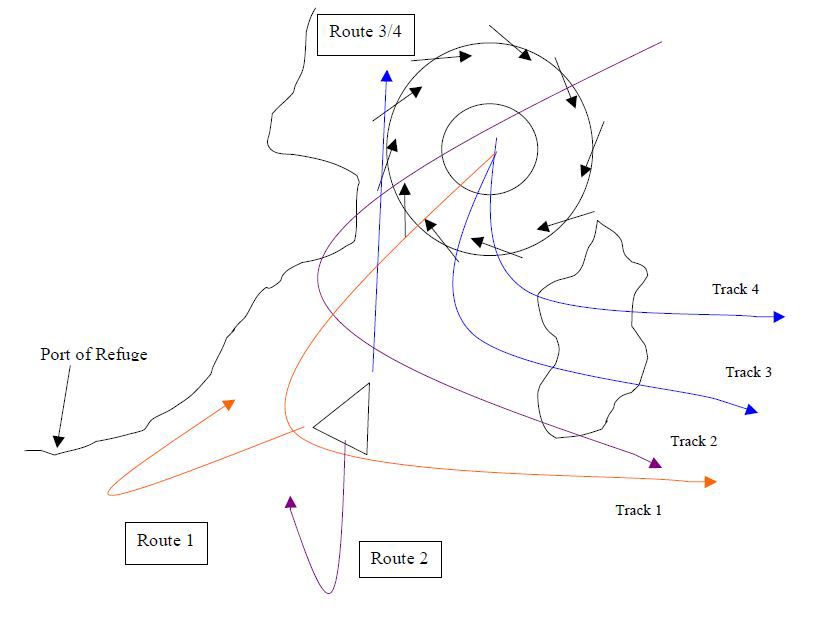
Comparison of the different tracks chosen for the avoiding the storm
- The Various tracks chosen for the storm movement are Route 1, 2, 3, 4 for corresponding tracks 1, 2, 3, 4 of
the storm - The movement of the TRS is as predicted in the Routeing chart for the month concerned and the general
tracks of TRS as given in Meteorology for mariners - While the tracks/paths may be for the past the TRS movement is highly erratic and therefore should be
continuously monitored by shore and onboard observation. - It might be required to alter or combine 1 or more of the routes predicted so as to counteract the TRS
movement. - Some of the storms are quite large and devastating effects can be caused by gale force winds up to 500 nm
from the centre. - The most serious consideration which ought to be in the mind of the Master deciding on the best course of
action is
- A maximum passing distance from the storm centre ( at least 250 nm from the storm centre)
- The vessel has to be kept in the Navigable semicircle of the TRS always as far as is practicable
where navigation permits. - Other navigational constraints like the proximity of land, Islands and also the endurance of the
vessel by way of Bunkers, provisions, water supply, nature of cargo etc. - Vessels speed if needed to out run the storm
- Presence of lee shore and loss of engine power or steering
- Possible recurvature of the TRS and change in her movement thereby standing the vessel in to
serious damage and putting lives at risk and causing serious environmental. - The commercial advantage gained by less distance steamed by passing closer to the storm centre
attains a miniscule value when comparing the cost involved with a pollution cleanup or other
environmental damages and loss of lives and cargo or the total constructive loss of the vessel.
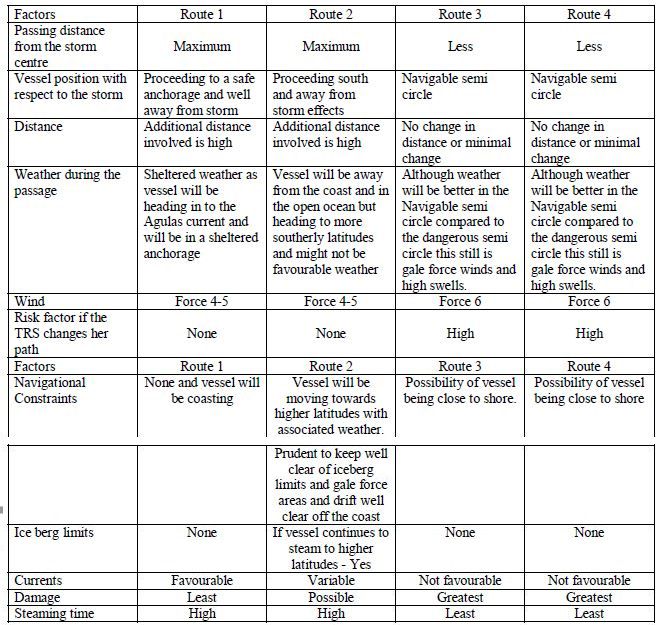
The track to be chosen by the master
- The master has a choice of either route 1 or 2.
- In Route 1 the vessel can continue to proceed in to a safe anchorage until the storm has passed away
- In route 2 the vessel has to proceed up to around 35˚ S and drift well off the course and then return to her
normal course once the storm has passed away. - In both the cases the storm has to be continuously monitored to ensure that vessel does not steam extra
distance unnecessarily and returns to her normal course at the earliest possible time when it is safe to do so.
